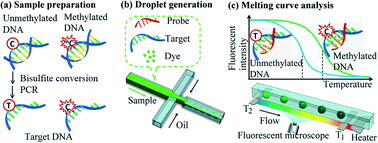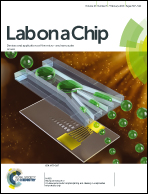DNA methylation assay using droplet-based DNA melting curve analysis
Abstract
DNA methylation is an epigenetic regulation of gene expression, which has drawn great attention in biomedical research due to its association with various diseases. A robust, inexpensive platform to detect and quantify the methylation status in a specific genomic region is necessary. In this study, an on-chip analytical technique of cytosine methylation with droplets in a microchannel is proposed. Genomic DNA samples are encapsulated into a series of droplets and transported through a detection region, where a stable temperature gradient is created. As the temperature is elevated from 60 °C to 85 °C, the DNA samples denature and the associated fluorescence signals decay, with the relationship being acquired as the melting curve. The droplets serve as discrete reactors for conducting DNA melting curve analysis in the liquid phase, thereby eliminating the need for immobilization of reagents. Due to a high heating rate and greater enhanced thermal stability, this microchip allows larger melting temperature differences for the samples at different percentages of methylated DNA. It has an enhanced discrimination ability and lower volume consumption, compared to the commercial qPCR machine. This chip enables quantification of the methylation levels of the pluripotent stem cell factor Oct-4 in its distal enhancer (DE) region, with a designed probe after bisulfite treatment and asymmetric PCR.



 Please wait while we load your content...
Please wait while we load your content...